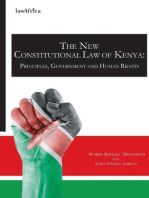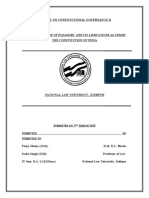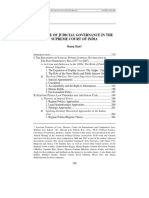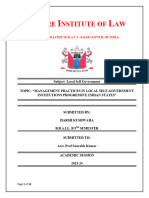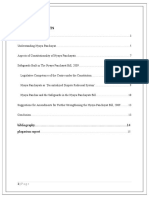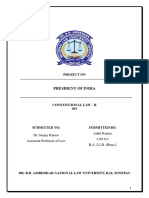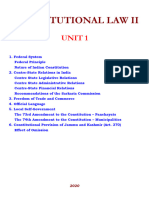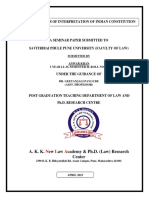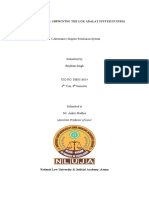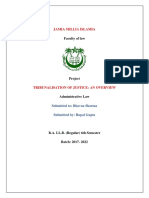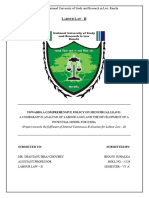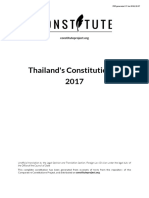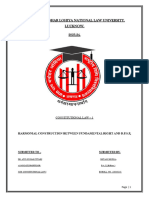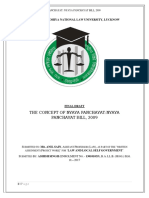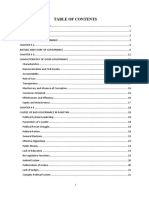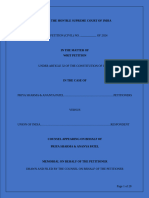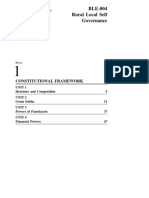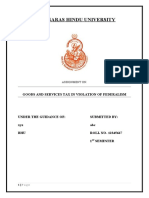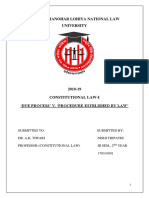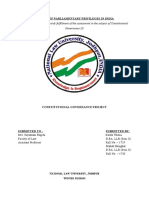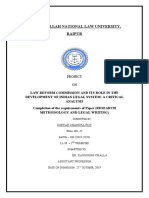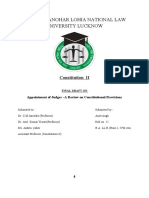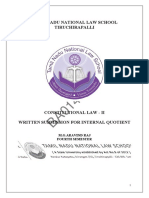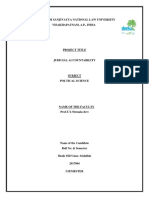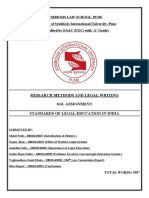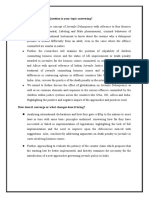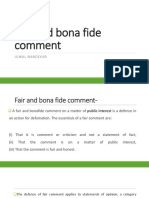R O N P I J D S ": Symbiosis Law School, Pune
R O N P I J D S ": Symbiosis Law School, Pune
Uploaded by
nupur jhodCopyright:
Available Formats
R O N P I J D S ": Symbiosis Law School, Pune
R O N P I J D S ": Symbiosis Law School, Pune
Uploaded by
nupur jhodOriginal Title
Copyright
Available Formats
Share this document
Did you find this document useful?
Is this content inappropriate?
Copyright:
Available Formats
R O N P I J D S ": Symbiosis Law School, Pune
R O N P I J D S ": Symbiosis Law School, Pune
Uploaded by
nupur jhodCopyright:
Available Formats
1ST INTERNAL ASSESSMENT OF COMPARATIVE CRIMINOLOGY & CRIMINAL
JUSTICE ADMINISTRATION
SYMBIOSIS LAW SCHOOL, PUNE
CARE | COURAGE | COMPETENCE | COLLABORATION
“COMPARATIVE CRIMINOLOGY & CRIMINAL JUSTICE ADMINISTRATION”
INTERNAL ASSESSMENT I
TITLE OF ASSIGNMENT-
“ROLE OF NYAYA PUNCHAYAT IN JUSTICE DELIVERY SYSTEM IN INDIA”
SUBMITTED BY –
NUPUR JHOD
I SEM, LLM (CRIMINAL LAW & SECURITY LAW)
PRN 20010143035 | ROLL NO. 035
SYMBIOSIS LAW SCHOOL, PUNE
TOTAL WORDS : 2467.
GUIDED BY –
Dr. BIBHABASU MISRA (ASSISTANT PROFESSOR),
SYMBIOSIS LAW SCHOOL, PUNE
PRN: 20010143035 Page 1
1ST INTERNAL ASSESSMENT OF COMPARATIVE CRIMINOLOGY & CRIMINAL
JUSTICE ADMINISTRATION
TABLE OF CONTENT
I. INTRODUCTION ……………....…......…………………………………………….3
1. HISTORY AND PRE-INDEPENDENCE PERIOD.................................................................................3
2. POST-INDEPENDENCE PERIOD..........................................................................................................3
II. CRITICAL ANALYSIS OF ROLE OF NYAYA PUNCHAYAT IN JUSTICE
DELIVERY SYSTEM...............………………………………………….…………. 4
A. ASHOK MEHTA COMMITTEE: 1977 .......................................................................................................5
B. REASONS FOR SETTING UP NYAYA PANCHAYATS..........................................................................6
C. CONSTITUTION OF NYAYA PANCHAYATS.........................................................................................6
D. JURISDICTION OF NYAYA PANCHAYATS...........................................................................................6
E. PROCEDURE IN NYAYA PANCHAYATS ...............................................................................................7
F. ADVANTAGES OF NYAYA PANCHAYATS OVER THE REGULAR
COURTS........................................................................................................................................................7
G. DISADVANTAGES OF NYAYA PANCHAYATS ....................................................................................7
III. COMPARISON BETWEEN NYAYA PUNCHAYAT LOCK ADALAT AND
GRAM NAYALAYAS.................................................................................................8
IV. ANALYSIS OF SUGGESTION AND RECOMMENDATIONS MADE BY LAW
COMMISSION AND COMMITTEE............................................................................9
i. 114TH REPORT OF LAW COMMISSION..........................................................................................9
ii. CIVIL JUSTICE COMMITTEE REOMMENDATIONS.................................................................10
V. RECENT DEVELOPMENTS.....................................................................................10
VI. CONCLUSION ….……………….…………............................................................12
VII. REFERENCE…...................…………………………………………………………13
PRN: 20010143035 Page 2
1ST INTERNAL ASSESSMENT OF COMPARATIVE CRIMINOLOGY & CRIMINAL
JUSTICE ADMINISTRATION
I. INTRODUCTION
1. HISTORY AND PRE-INDEPENDENCE PERIOD :
India being a country of the ancient civilization in the world possesses a valuable heritage in
the field of administration of justice. India’s rich cultural heritage in the field of
administration of justice and the need to bring those institutions in the form of Nyaya
Panchayat (Village Court), to provide justice to millions of villagers through the concept of
Nyaya Panchayat.1 Rabindra Nath Tagore also supported and he was of the view that our
aims must be to restore to the Villages the Power to meet their own requirement.
The term Panchayat literally means council of five. The principle underlying Panchayat is
“Panch Parmeshwar” which means God speaking through five.2 In India, Nyaya Panchayats
have existed since ancient times and played very important role in dispute resolution in
villages. In Vedic age there were in existence of Panchayat republics.3 In the ancient Smriti
texts we also find reference of some village institutions viz., Kula, Sreni and Puga.4
British milers set up their courts to resolve the disputes. The people too realized that the
power of State was behind these courts and not behind old village Panchayats. Hence the
importance of the Panchayats day-by-day started losing their importance. But, during the later
part of the British period they made some effort to restore the condition of village panchayat
with Village Court Acts of 1888. Which created panchayat courts for the administration of
justice.5
2. POST-INDEPENDENCE PERIOD:
From the analysis of Constituent Assembly Debates it is clear that the Ambedkar group 6
rejected the philosophy of the supremacy of Panchayati Institutions and for that reason the
Draft Constitution did not make any reference to Panchayat Institution. In fact socio-political
factors did play a momentous role in the non-inclusion of the name of the Panchayati
institution in the Draft Constitution. Pachayats were included in Article 40 under the
1
Kumar Girish, Local Democracy in India: Interpreting Decen tralization (Sage publications New Delhi, 2006).
2
B.K.Raina, Working of Panchayati Adalats, A Case Study 33 (Cochin University Law Review, 2008).
3
Indian Bar Review, Vageshwari 74 (2010).
4
Id At 3.
5
Ghosh Rathna, Pramanik Alok Kumar 209-210 (1999).
6
N.G. Ayyanagar, K. M. Munshi, Saiyed M. Saddula, B.L.Mitter and Dr. D. P. Khetan, The views of Dr.
Ambedkar 254 (2012).
PRN: 20010143035 Page 3
1ST INTERNAL ASSESSMENT OF COMPARATIVE CRIMINOLOGY & CRIMINAL
JUSTICE ADMINISTRATION
Directive Principles of the Constitution of India.7 The importance of this article is that the
power of the people, which is the soul of a republic, stands subverted if decentralization and
devolution desiderated in Article 40 is ignored by Executive in action even after holding
elections to the floor-level of administrative bodies. 8 The Panchayats has simulated a special
significance in the context of the fundamental aims of our political, economic and social
development of our country. These institutions are expected to be as sin qua non of our rural
programmes especially related to rural India to fight against poverty, injustice and
exploitation.9
II. CRITICAL ANALYSIS OF ROLE OF NYAYA PUNCHAYAT IN
JUSTICE DELIVERY SYSTEM
The real effort, one can witness, was made only after independence, where a separate
provision was made in Article 40 of the Constitution of India, which declares, “The State
shall take steps to organize village panchayat and endow them with such power and authority
as may be necessary to enable them to function as units of self government.10
The aforesaid Article must be read with Article 39-A of the Constitution which directs the
State to ‘secure that the operation of the legal system promotes justice, , on the basis of equal
opportunity and shall in particular, provide free legal aid, by suitable legislation of scheme or
in any other way, to ensure that opportunity for securing justice are not denied to any citizen
by reason of economic or other disabilities”. Thanks to the seventy third Amendment Act of
1992 the village panchayats have been blessed Constitutional status11.The 73rd amendment
brought a new perspective to decentralization and political empowerment of women.
Nyaya Panchayats are the judicial components of the panchayat system, which forms the
lowest rung of our judiciary. They are created for the administration of justice at the local or
rular level.
A. ASHOK MEHTA COMMITTEE: 1977
7
Bharatada Samvidhana, Kannada version of Constitution of India 19 (Government of India, 2001).
8
N.M.Kheni v Manik Rao Patil, AI R 1977 SC 2171 (Goswami, P.K.).
9
Sibnath Bhattacharya, Rural Poverty In India, 137 (1989).
10
M P Jain, Indian Constitutional Law (6th ed. Lexis Nexis Butterworths Wadhwa, 2010).
11
The Constitution (Seventy -Third Amendment) Act, Government of India (1992).
PRN: 20010143035 Page 4
1ST INTERNAL ASSESSMENT OF COMPARATIVE CRIMINOLOGY & CRIMINAL
JUSTICE ADMINISTRATION
One of the major issues in context with the Panchayati Raj Institutions (PRIs) was that it got
dominated by the privileged section of the village society. In December 1977, 13 member
committee headed by Mr. Ashok Mehta. The committee was appointed for following:
What are the causes responsible for poor performance of the PRIs?
What measures should be taken to improve performance of the PRIs?
The Ashok Mehta committee submitted its report in 1978 and made more than 130
recommendations. The essence of Ashok Mehta Committee recommendations is as follows:
3-tier should be replaced by the 2-tier system. The upper tier would be the Zila Parishad
at the district level and lower tier should be the Mandal Panchayat, which should be a
Panchayat of group of villages covering a population of 15000 to 20000.
The committee recommended that the base of the Panchayati Raj system should be a Mandal
Panchayats. Each Mandal panchayat should contain 15 members directly elected by the
people. The head of the Mandal Panchayat should be elected among the members themselves.
Zila Parishad should be the executive body and made responsible for planning at the district
level. The Zila Parishad members should be elected as well as nominated.
Thus, we see that the Ashok Mehta Committee recommended abolishing the middle trier
i.e. Blocks as unit of administration. It recommended that the district should be the first
point for decentralization under popular supervision below the state level.
One more important recommendation of this committee was that there should be Nyaya
Panchayats as separate bodies from that of development Panchayats. The Nyaya
Panchayats should be presided over by a qualified judge.
It was the Ashok Mehta Committee that recommended that there should be a minister for
Panchayati Raj in the state council of ministers to look after the affairs of the Panchayati Raj
institutions.
In summary, the democratic decentralization initiated by the Balwant Rai Mehta Committee
were taken forward by the Ashok Mehta Committee. But before any action could be taken on
the recommendations of this committee, the Janta Government collapsed. So, the zeal to
implement the recommendations got wiped out. However, West Bengal and
Karnataka were two states that took initiatives on the basis of recommendations of the
Ashok Mehta Committee.
PRN: 20010143035 Page 5
1ST INTERNAL ASSESSMENT OF COMPARATIVE CRIMINOLOGY & CRIMINAL
JUSTICE ADMINISTRATION
As per the recommendations the Karnataka Government passed the Karnataka Zilla
Parishads, Taluk Panchayat Samitis, Mandal Panchayats and Nyaya Panchayats Act, 1983
(Karnataka Act 20 of 1985)
The Ashok Mehta committee noted that except the states of Maharastra and Gujarat, the PRIs
were not given an opportunity to take up implementation at a satisfactory level. Committee
noted that the bureaucracy was also responsible for the decline for particularly two reasons:
The officers felt that they are primarily accountable to the State Governments.
They were not able to adjust to the working under the supervision of the elected
representatives.
B. REASONS FOR SETTING UP NYAYA PANCHAYATS
The rationale behind setting up the Nyaya Panchayat are:-
1. Democratic decentralisation,
2. Easy access to justice,
3. speedy disposal of cases,
4. Inexpensive justice system.
5. Revival of traditional village community life,
6. Combination of judicial system and local self government, and
7. Reduction in pressure on Civil Courts.
C. CONSTITUTION OF NYAYA PANCHAYATS
Nyaya Panchayats constitutes a Sarpanch as its head and few panchai (generally it varies
between 10 to 30). Each member of Nyaya panchyat must be literate and must be of
minimum 30 years of age. The appointment is based on nomination and election
D. JURISDICTION OF NYAYA PANCHAYATS
It has judicial functions both in civil as well as in criminal fields. It can deal with several
minor offences) like simple hurt, wrongful restraint, theft etc, and punish an accused to pay
fine. In civil matters nyaya panchayat have jurisdiction in cases like suits for money and
goods etc. The pecuniary limit of such cases is very low.
E. PROCEDURE IN NYAYA PANCHAYATS
PRN: 20010143035 Page 6
1ST INTERNAL ASSESSMENT OF COMPARATIVE CRIMINOLOGY & CRIMINAL
JUSTICE ADMINISTRATION
The procedure laid down for trial of cases has been so designed as to avoid delays and
technical difficulties. Therefore procedure followed in nyaya panchayats is very simple and
informal.12 The procedure codes like Code of Civil Procedure, Criminal Procedure Code and
Indian Evidence Act apply to the nyaya panchyats, but, they have power to call witnesses and
the parties for recording their evidence or producing any relevant document or fact. Unlike
courts, they have the power to investigate the facts to find out the truth and at the same time
they have the power to punish for its contempt. Lawyers cannot appear before a nyaya
panchyat in any of its proceedings
F. ADVANTAGES OF NYAYA PANCHAYATS OVER THE REGULAR COURTS:
1. They provide a inexpensive and expeditious mechanism to settle disputes.
2. They provide relief to the ordinary
Independence
courts as they lift the part of burden of Flourished From pre-
judicial work on their shoulders. In a electorate
way, they are emerged on solution to the Personnel Elected by local
problem of mounting arrears of cases
Norms Statute law.
before the courts. Applied
3. They provide justice at the door steps Maximum Fines.
Penalty
for the village folk,
4. They provide protection to the local Appeals
Courts.
customs and traditions,
Representati Self.
5. Panchayat System has a great educative on
value for the villagers.
G. DISADVANTAGES OF NYAYA PANCHAYATS
1. They are faction ridden institutions manned by laymen. Justice provided by them is
based on caste, community, personal or political considerations. Therefore, chances of
injustice cannot be ignored,
2. It has been seen that panchas are often corrupt, partial & behave improperly or rudely.
3. They are laymen, therefore ignorant of law and they often give arbitrary and
irrational decisions,
12
Law Commission of India 883 (1958).
PRN: 20010143035 Page 7
1ST INTERNAL ASSESSMENT OF COMPARATIVE CRIMINOLOGY & CRIMINAL
JUSTICE ADMINISTRATION
4. One cannot ignore that castism and groupings are major features of rural India and
therefore the influence of these shades on the justice cannot be According to 77th
Report of the Law Commission, wherein it observed that, it will be a backward step to
revert to the premitive method of administration of justice by taking out disputes to a
group of ordinary laymen ignorant of modern complexities of life and not conversant
with legal concepts and procedures.
The Mehta Committee did not get very enthusiastic response on the continuation and
working of the nyaya panchayat. It opposed the combination of judicial and executive
functions in one body and also recommended qualified judges to preside over nyaya
panchayat.13
III. COMPARISON BETWEEN NYAYA PUNCHAYAT LOCK
ADALAT AND GRAM NAYALAYAS
NYAYA PUNCHAYAT LOK ADALATS GRAM NYAYALAYAS
Flourished From pre-Independence. 1982 onwards. Proposed.
Personnel Elected by local electorate Retired judges, Nyayadhikaris selected by
volunteers High Court.
Norms Applied Statute law. Not known. State law, conciliation.
Maximum Penalty Fines. Enforced by court. Imprisonment up to one
year, fines.
Appeals Courts. No appeal. Assistant Sessions judge /
senior civil judge.
Representation Self. Self, lawyers. Self, lawyers.
IV. ANALYSIS OF SUGGESTION AND RECOMMENDATIONS
MADE BY LAW COMMISSION AND COMMITTEE
13
BalwantRai Mehta Committee (1958).
PRN: 20010143035 Page 8
1ST INTERNAL ASSESSMENT OF COMPARATIVE CRIMINOLOGY & CRIMINAL
JUSTICE ADMINISTRATION
i. 114TH REPORT OF LAW COMMISSION:14
Law Commission in its 114th Report concluded that, “with the safeguards designed to
ensure nyaya panchayats proper working and improvement. These courts are capable of
playing a very necessary and useful part in the administration of justice in the country.” In
this Report the Law Commission presented a new model for the establishment of nyaya
panchayats.
The suggested model is as follows:
1. There should be a panchayat judge and two lay judges in a nyaya panchayat. Where the
panchayat judge should be legally trained person belonging to the cadre of judges to be
specifically set up for the purpose.15
2. In order to select legally trained judge for nyaya panchayats the state shall constitute a
special cadre of Judges that is panchayati raj cadre of judges.
3. The lay judges should be nominated not elected. The-local jurisdiction of the gram
nyayala would be over villages comprised in a Taluka/Tehsil.
4. There would be no monetary ceiling on its jurisdiction. A broad civil jurisdiction should
be given, and the criminal jurisdiction should be equal to that of a judicial magistrate of
first class.
5. The nyaya panchayat would follow a simple procedure to dispose the cases.
6. Neither the Code of Civil Procedure, 1908, nor the Indian Evidence Act, 1872 is to be
applied in its procedure.
7. In criminal trials, the Code of Criminal Procedure, 1973 is to be applied but Indian
Evidence Act, 1872 should not applicable.16
8. Lawyers should be permitted to appear before the nyaya panchyats.
9. No appeal shall lie in civil cases from the decisions of the nyaya panchayats, But a
revision petition may lie to correct errors of law which may have affected the decision of
the nyaya panchayats to the district courts.
10. In criminal case, an appeal would lie to the sessions courts against the decisions of the
nyaya panchayats in which it was imposed a substantive sentence of imprisonment.
14
Law Commission of India, 114th Report: Gram Nyayalaya 1 (1986).
15
Law Commission of India 28-29 (1986).
16
Law Commission of India 31 (1986).
PRN: 20010143035 Page 9
1ST INTERNAL ASSESSMENT OF COMPARATIVE CRIMINOLOGY & CRIMINAL
JUSTICE ADMINISTRATION
ii. CIVIL JUSTICE COMMITTEE REOMMENDATIONS:
Moreover, as was recommended by the Civil Justice Committee,17 each party may be
allowed to choose its own pancha and the Sarpancha or the Presiding Officer of the
Panchayat Court should have a casting vote. Yet another improvement to ensure impartiality
can be to bring the dispute between two parties belonging to a particular village before the
panchas belonging to another village will have no interest in the case or the dispute and will
be in a position to impart justice.
Even, otherwise, there should be regular inspection of the Nayaya Panchayat by the
Tehsildar/Sub Divisional Officer or by the District Munsif himself to ensure that the
proceedings of the Nayaya Panchayat are free from caste/faction consideration. There should
be a provision for an appeal to the Munsif in case any party feels aggrieved by the decision.
Such provision should be there to keep a check on the functioning of the Panchayats.
To ensure impartiality, the District Munsif should have the power to transfer a case from a
Panchayat and decide it himself. It could be done on the request of a litigant who may feel
that justice would be denied to him by the village Panchayat. Such provision will act as a
good check on the function and performance of the Nayaya Panchayats.
V. RECENT DEVELOPMENTS
The Standing Committee on Rural Development (Chair: Dr. P Venugopal) submitted its
report on ‘Improvement in the functioning of Panchayats’ on July 19, 2018. 18 The
participation of local people for development of rural areas through the Panchayati Raj
System was provided in the Indian Constitution through the 73rd amendment. Key findings
and recommendations of the Committee with regard to the functioning of panchayats include:
Devolution of powers: The Ministry of Panchayati Raj has issued comprehensive guidelines
for the effective functioning of panchayats. However, the Committee noted that the
mandatory meetings of panchayats were not taking place and had poor attendance, especially
from women representatives. The Committee recommended that state governments should
put a quorum in gram sabha meetings for participation of panchayat representatives,
including women. Also, The Committee recommended that the State governments should
17
Civil Justice Commitee, 1924-25 S Report 105 (Government of India Central Publication Branch, 1925).
18
Standing Committee Report, Summary Improvement in the functioning of Panchayats (2014).
PRN: 20010143035 Page 10
1ST INTERNAL ASSESSMENT OF COMPARATIVE CRIMINOLOGY & CRIMINAL
JUSTICE ADMINISTRATION
make adequate efforts to devolve funds, functions, and functionaries to panchayats for them
to effectively plan economic development and social justice schemes.
Funding of panchayats: Grants from Finance Commission play an important role in the
implementation of schemes by panchayats. These grants are intended to be used to support
and strengthen the delivery of basic services including water supply, sanitation, sewerage and
solid waste management and any other basic service within the functions assigned to
panchayats under relevant legislations. The Committee noted that some state governments
have delayed releasing funds to panchayats. The Committee recommended that the Ministry
should monitor the release and expenditure of Finance Commission grants to ensure that
there is no delay in their release. It should also be ensured that grants are utilised in a proper
and effective manner. Panchayats should also be encouraged to carry out local audits
regularly so that Finance Commission grants are not delayed.
Capacity building: The Rajiv Gandhi Panchayat Sashaktikaran Abhiyan was implemented
from 2012-13 to 2015-16 to address issues such as inadequate infrastructure, manpower
training, and advocacy of devolution of power to panchayats. Since 2015-16, the state
component of the scheme was delinked from central support due to larger devolution of funds
from the 14th Finance Commission. The Committee recommended that strengthening of
panchayats through capacity building and training should be given more encouragement from
the centre and state governments. This would enable them to prepare better Gram Panchayat
Development Plans, as well as become more responsive towards citizens’ needs.
Support staff: The Committee observed that there is severe lack of support staff and
personnel in panchayats, such as secretary, junior engineers, computer operators, and data
entry operators. This affects their functioning and delivery of services by them. The
Committee recommended that the Ministry should make serious efforts towards recruitment
and appointment of support and technical staff to ensure the smooth functioning of
panchayats.
VI. CONCLUSION
Over 60 years of independence, the search for acceptable and accessible legal institution for
those living in rural India is still on-going. At many times, this seach has been punctuated by
calls to return to traditional or indigenous forms and mechanism for dispute resolution. The
PRN: 20010143035 Page 11
1ST INTERNAL ASSESSMENT OF COMPARATIVE CRIMINOLOGY & CRIMINAL
JUSTICE ADMINISTRATION
‘village panchayat’ ideal and its interpretation through Nyaya Panchayats are the most
notable attempts by the Indian state to operationalised this return. When 65% of our
population resides in rural India, there seems to be no escape from some form of nyaya
panchayat. We need an effective institution which can provide justice near to the door steps
for the rural India. Otherwise, the justice will remain to be for the urban courts, which is far
from the reach of poor rural people. Therefore, to provide a semblance of justice, Nyaya
panchayats in some form have to be created on the basis of participation of the people. The
Seventy third amendment of the Constitution has given right direction in this regard. The
failure of those institutions was evidence of both the inaccuracy of the village panchayat idea,
as well as its unavailability as a guide for meaningful reform.
Gram Nyayalays are the next major change. Like Nyaya Panchayats, they are intended to
provide persons in rural areas village level access to judicial institutions. They are however,
strikingly different in both their structure and functioning. At no point do they claim to offer
a particularistic, localised form of dispute resolution. For the most part, they embrace a
professionalised model of justice delivery founded on the idea of adversarial adjudication. In
this respect, they are much closer to the ‘formal’ courts in the country than to any indigenous
or traditional institutions, real or idealised. In the broad story of the Indian legal system, the
move from Nyaya Panchayats to Gram Nyayalayas likely signifies the conclusive end of ste
attempts tp return to traditional models of dispute resolution, and the move towards a model
based on the slow and stedy expansion of the formal court system.
VII. REFERENCE
BOOKS :
1. S. N. Mathur, Nyaya panchayats as instruments of justice (1997).
JOURNALS/ARTICLES:
i. Marc Galanter and Jayanth K. Krishnan, Bread for the Poor: Access to Justice and the
Rights of the Needy in India, Hastings Law Journal, 789 (2004).
ii. Panel to draft nyaya panchayat bill, The Hindu (Jun. 25, 2006).
iii. Law ministry: Nyaya Panchayat Bill is 'unconstitutional', Times of India (8 Jul. 2007).
iv. Ministry of Panchayati Raj indicates that there are 6,097 panchayats at the intermediate
level, Annual Report (2005-06).
PRN: 20010143035 Page 12
1ST INTERNAL ASSESSMENT OF COMPARATIVE CRIMINOLOGY & CRIMINAL
JUSTICE ADMINISTRATION
v. D Bandyopadhyay, Nyaya Panchayats, Economic and Political Weekly 5372-75 (Dec. 17,
2005).
vi. Milestones, Press Information Bureau (2002),
http://pib.nic.in/archieve/ppinti/milestones2002/milestones_02_law_justice.html.
vii. Judicial System and Reforms in Asian Countries: the Case of India, Indian Law Institute
(2001), http://www.ide.go.jp/English/Publish/Als/pdf/03.pdf.
viii. Major Policy Decisions Taken by the State Government of Chhattisgarh ,
http://www.chhattisgarh.nic.in/policy/cpolicy.htm.
ONLINE DATABASES
1. Westlaw (www.westlawindia.com)
2. SCC Online (www.scconline.com)
3. Lexis Nexis (www.lexisnexis.com)
PRN: 20010143035 Page 13
You might also like
- Viaje A MadridDocument294 pagesViaje A Madridbigliang98No ratings yet
- Assignment 3 - Lien ProceduresDocument12 pagesAssignment 3 - Lien Proceduresrajnishatpec100% (2)
- The New Constitutional Law of Kenya. Principles, Government and Human Rights: Principles, Government and Human RightsFrom EverandThe New Constitutional Law of Kenya. Principles, Government and Human Rights: Principles, Government and Human RightsRating: 3 out of 5 stars3/5 (2)
- Public Private Partnerships: Presented by Jerry Fay, PEDocument29 pagesPublic Private Partnerships: Presented by Jerry Fay, PEPrav Srivastava100% (1)
- Consti Law 2 ProjectDocument28 pagesConsti Law 2 ProjectSanjith C100% (1)
- Vivek Kumar Gupta, LSG Research PaperDocument19 pagesVivek Kumar Gupta, LSG Research PaperHarsh kushwahaNo ratings yet
- The Rise of Judicial Governance in The Supreme Court of IndiaDocument56 pagesThe Rise of Judicial Governance in The Supreme Court of IndiaMAHANTESH GNo ratings yet
- hARSH LSG RESEARCH PAPERDocument32 pageshARSH LSG RESEARCH PAPERHarsh kushwahaNo ratings yet
- Local Self GovernmentDocument14 pagesLocal Self GovernmentbzhhahahahajnaNo ratings yet
- Constitutional Law II - Unit 2Document58 pagesConstitutional Law II - Unit 2devyanimulgund116No ratings yet
- Project On Constituional Governance 2 Doctrine of PleasureDocument28 pagesProject On Constituional Governance 2 Doctrine of PleasureAnamikaSingh100% (1)
- Project Consti AnkitDocument36 pagesProject Consti Ankitankitdangi394No ratings yet
- Towards Improving GovernanceDocument250 pagesTowards Improving GovernanceBiswadip BanerjeeNo ratings yet
- Constitutional Law II - Unit 1Document55 pagesConstitutional Law II - Unit 1devyanimulgund116No ratings yet
- Polity 2Document59 pagesPolity 2SatyaSwagat SutarNo ratings yet
- Midterm Project - Administrative LawDocument67 pagesMidterm Project - Administrative LawIshita UpraleNo ratings yet
- Best ADocument37 pagesBest APrerna GalaNo ratings yet
- Doctrine of Pleasure (Consti-I)Document41 pagesDoctrine of Pleasure (Consti-I)ANANYANo ratings yet
- Law Making.3Document26 pagesLaw Making.3Shabnam SayalNo ratings yet
- Administrative LawDocument23 pagesAdministrative LawHimanshumalik0% (1)
- 14 NUJSLRev 1Document54 pages14 NUJSLRev 1aritra mitraNo ratings yet
- Justice For All: Improving The Lok Adalat System in India: 8.3 Alternative Dispute Resolution SystemDocument20 pagesJustice For All: Improving The Lok Adalat System in India: 8.3 Alternative Dispute Resolution SystemBrijbhan Singh Rajawat100% (1)
- Tribunalisation of Justice - Administrative LawDocument20 pagesTribunalisation of Justice - Administrative LawRupal GuptaNo ratings yet
- Constitutionality of Minimum Wages Act 1948: Guided By: Prof. Nuzhat ParweenDocument55 pagesConstitutionality of Minimum Wages Act 1948: Guided By: Prof. Nuzhat ParweenHuzaifa SalimNo ratings yet
- Law of Crimes Sumary Notes 6JULY2023Document52 pagesLaw of Crimes Sumary Notes 6JULY2023priyanka.elixirlegalNo ratings yet
- Labour Law II - 1228Document27 pagesLabour Law II - 1228bhanusuhalka.nusrlNo ratings yet
- Federal Relations Between Delhi Government and Lieutenant GovernerDocument11 pagesFederal Relations Between Delhi Government and Lieutenant GovernerSamay TulsyanNo ratings yet
- Continuing Mandamus Mihika BhavyaDocument42 pagesContinuing Mandamus Mihika BhavyamanasranNo ratings yet
- Pol SC PRJDocument23 pagesPol SC PRJchetanchodaNo ratings yet
- Role of Public Service Commission To Establish An Effective Administrative Machinery in The Country PDFDocument7 pagesRole of Public Service Commission To Establish An Effective Administrative Machinery in The Country PDFRanaRanveerNo ratings yet
- Constitution Project FinalDocument20 pagesConstitution Project FinalranzymanzyNo ratings yet
- Constitutional Law-I Assignment Semester 3Document16 pagesConstitutional Law-I Assignment Semester 3AnonymousNo ratings yet
- Thailand 2017Document109 pagesThailand 2017Christine Natalia TripamaNo ratings yet
- Project Work OF: Gram Panchayat Consitution, Power and Functions Under U.P. Panchayat Raj Act, 1947Document14 pagesProject Work OF: Gram Panchayat Consitution, Power and Functions Under U.P. Panchayat Raj Act, 1947aruba ansari50% (2)
- Comparative Public Law Project: Critical Anaysis of Judicial Activism For Protecting Human Rights (India & Usa)Document30 pagesComparative Public Law Project: Critical Anaysis of Judicial Activism For Protecting Human Rights (India & Usa)tanmayklNo ratings yet
- Report Disruptions+in+the+Indian+Parliament VidhiDocument79 pagesReport Disruptions+in+the+Indian+Parliament VidhiRakesh SahuNo ratings yet
- Admin Law Project - Ujjwal and VanshikaDocument53 pagesAdmin Law Project - Ujjwal and VanshikaUjjwal AgrawalNo ratings yet
- Consti 1 ProjectDocument23 pagesConsti 1 Projectshivamshukla2300No ratings yet
- Local Self GovernmentDocument15 pagesLocal Self GovernmentAshish SinghNo ratings yet
- Thailand 2017 ConstitutionDocument109 pagesThailand 2017 ConstitutionEthan ChenNo ratings yet
- Good Governance in Pakistan Problems and Possible SolutionsDocument45 pagesGood Governance in Pakistan Problems and Possible SolutionsANas Ali67% (15)
- Moot Memorial PetitionerDocument28 pagesMoot Memorial Petitionersujeet.kumarbdpsNo ratings yet
- Block-1 CONSTITUTIONAL FRAMEWORKDocument58 pagesBlock-1 CONSTITUTIONAL FRAMEWORKSachin SonawaneNo ratings yet
- Banaras Hindu University: Goods and Services Tax in Violation of FederalismDocument16 pagesBanaras Hindu University: Goods and Services Tax in Violation of FederalismSmita PatelNo ratings yet
- Project, Basics of LegislationDocument18 pagesProject, Basics of LegislationNAVEEL ISLAMNo ratings yet
- Constitutional Law IDocument20 pagesConstitutional Law INishiNo ratings yet
- Constitution Law Project (1729 and 1730)Document22 pagesConstitution Law Project (1729 and 1730)Mahak ShinghalNo ratings yet
- Labour LawDocument19 pagesLabour LawPrasenjit TripathiNo ratings yet
- Memorial Respondent ThemisDocument34 pagesMemorial Respondent ThemisMeenakshi Sharma100% (1)
- The Rise of Judicial Governance in The Supreme Court of IndiaDocument56 pagesThe Rise of Judicial Governance in The Supreme Court of IndiaAnonymous vy6nevNo ratings yet
- BP Apte Memo PetDocument44 pagesBP Apte Memo PetBivviN ShahrerNo ratings yet
- Hidayatullah National Law University, RaipurDocument42 pagesHidayatullah National Law University, RaipurIshwarNo ratings yet
- Memorial For PetitionerDocument18 pagesMemorial For Petitioneraryan mukherjeeNo ratings yet
- Dr. Ram Manohar Lohia National Law University Lucknow: Constitution IIDocument13 pagesDr. Ram Manohar Lohia National Law University Lucknow: Constitution IIAmit SinghNo ratings yet
- Banking FDDocument22 pagesBanking FDtanushkashukla90No ratings yet
- Constitutional Mandate of The Chief Justice of IndiaDocument14 pagesConstitutional Mandate of The Chief Justice of IndiaShraddha YadavNo ratings yet
- Tamilnadu National Law School Tiruchirapalli: M.G.Aravind Raj Fourth SemesterDocument74 pagesTamilnadu National Law School Tiruchirapalli: M.G.Aravind Raj Fourth SemesterAnuraj meenaNo ratings yet
- Memorial For Ready ReferenceDocument31 pagesMemorial For Ready ReferenceManisha VermaNo ratings yet
- Belgavi Moot Court RespondantDocument29 pagesBelgavi Moot Court RespondantHiya HegdeNo ratings yet
- Dr. Ram Manohar Lohiya National Law University: Submitted To Submitted byDocument15 pagesDr. Ram Manohar Lohiya National Law University: Submitted To Submitted byAniket SachanNo ratings yet
- Administrative Tribunals in IndiaDocument20 pagesAdministrative Tribunals in IndiaPrashant Mahawar100% (1)
- Judicial Accountability Project PsDocument24 pagesJudicial Accountability Project PsRupesh 1312No ratings yet
- Preventive Actions of Police: A Project Proposal Made byDocument23 pagesPreventive Actions of Police: A Project Proposal Made bynupur jhodNo ratings yet
- Cyber Jurisprudence - IiDocument13 pagesCyber Jurisprudence - Iinupur jhodNo ratings yet
- Petitioner IMS MOOT #2Document29 pagesPetitioner IMS MOOT #2nupur jhodNo ratings yet
- Ntroduction: Law Commission in India For The First Time Lad Down Certain Guideline For The Plea BargainingDocument5 pagesNtroduction: Law Commission in India For The First Time Lad Down Certain Guideline For The Plea Bargainingnupur jhodNo ratings yet
- Standards of Legal EducationDocument7 pagesStandards of Legal Educationnupur jhodNo ratings yet
- Memorial RamanDocument4 pagesMemorial Ramannupur jhodNo ratings yet
- Rights and DutiesDocument16 pagesRights and Dutiesnupur jhod0% (1)
- Dos Donts of E-Commerce TransactionsDocument11 pagesDos Donts of E-Commerce Transactionsnupur jhodNo ratings yet
- Negligence - Dangerous GoodsDocument20 pagesNegligence - Dangerous Goodsnupur jhodNo ratings yet
- Which Law and Justice Question Is Your Topic Answering?Document1 pageWhich Law and Justice Question Is Your Topic Answering?nupur jhodNo ratings yet
- Company Law 1ST Internal AssismentDocument13 pagesCompany Law 1ST Internal Assismentnupur jhodNo ratings yet
- Basic Concept of Fair TrialDocument4 pagesBasic Concept of Fair Trialnupur jhodNo ratings yet
- Theater 2ND Internal AssismentDocument3 pagesTheater 2ND Internal Assismentnupur jhodNo ratings yet
- Symbiosis Law School, Pune: Internal Assessment OF International Criminal LawDocument7 pagesSymbiosis Law School, Pune: Internal Assessment OF International Criminal Lawnupur jhodNo ratings yet
- Fair & Bona Fide CommentDocument19 pagesFair & Bona Fide Commentnupur jhodNo ratings yet
- Negligence - Keeper of AnimalsDocument25 pagesNegligence - Keeper of Animalsnupur jhodNo ratings yet
- Negligence - Dangerous GoodsDocument20 pagesNegligence - Dangerous Goodsnupur jhodNo ratings yet
- Fair & Bona Fide CommentDocument19 pagesFair & Bona Fide Commentnupur jhodNo ratings yet
- Crimes and Punishment in Mughal RuleDocument8 pagesCrimes and Punishment in Mughal Rulenupur jhod100% (1)
- Expert Witness Statement FinalDocument1 pageExpert Witness Statement Finalnupur jhodNo ratings yet
- Forensic Report RevisedDocument7 pagesForensic Report Revisednupur jhodNo ratings yet
- Post Mortem Report FinalDocument3 pagesPost Mortem Report Finalnupur jhod100% (1)
- Annexure Iv Forensic Report Sasoon Civil HospitalDocument5 pagesAnnexure Iv Forensic Report Sasoon Civil Hospitalnupur jhodNo ratings yet
- Writ Up CompetitionDocument3 pagesWrit Up Competitionnupur jhodNo ratings yet
- Indian Political Science Association The Indian Journal of Political ScienceDocument11 pagesIndian Political Science Association The Indian Journal of Political Sciencenupur jhodNo ratings yet
- Icm Project ReportDocument107 pagesIcm Project ReportJibin anandNo ratings yet
- Thomas Merton Book of SilentDocument14 pagesThomas Merton Book of SilentBryen GarciaNo ratings yet
- MC34063 STmicroDocument23 pagesMC34063 STmicroFady HachemNo ratings yet
- Typical Mistakes-C (M.Swan 'Practical English Usage') 2018Document1 pageTypical Mistakes-C (M.Swan 'Practical English Usage') 2018Евгения МартыноваNo ratings yet
- Full-Year Results 2018: Press ConferenceDocument22 pagesFull-Year Results 2018: Press ConferenceDebasish SahooNo ratings yet
- Bahasa InggrisDocument3 pagesBahasa InggrisFadia Rahmah AshariNo ratings yet
- Grand Banks Announces Sale of 54 Heritage EU Luxury Boat To Local Buyer at Recent Singapore Yacht ShowDocument2 pagesGrand Banks Announces Sale of 54 Heritage EU Luxury Boat To Local Buyer at Recent Singapore Yacht ShowWeR1 Consultants Pte LtdNo ratings yet
- Bob Internet BankingDocument12 pagesBob Internet BankingSweta PandeyNo ratings yet
- IT Audit ChecklistDocument40 pagesIT Audit ChecklistPatricia Zhonga100% (6)
- Trademark Registration TM 48 For Indian TrademarkDocument2 pagesTrademark Registration TM 48 For Indian TrademarkOovesh SaraNo ratings yet
- DGR REGULATION - Section 18 - Dangerous Goods by Air - Edition 2.0Document49 pagesDGR REGULATION - Section 18 - Dangerous Goods by Air - Edition 2.0kecildaimNo ratings yet
- Optical Storage Media Industry Report-1Document39 pagesOptical Storage Media Industry Report-1saahil.goel6110100% (1)
- Screenplay Writing The Picture 2nd Edition Robin U. Russin & William Missouri Downs All Chapter Instant DownloadDocument34 pagesScreenplay Writing The Picture 2nd Edition Robin U. Russin & William Missouri Downs All Chapter Instant DownloadkaiedasaguNo ratings yet
- Indian Automobile IndustryDocument55 pagesIndian Automobile Industrysaurabhtayal88No ratings yet
- DA203 C1 Rev 10Document1,290 pagesDA203 C1 Rev 10nikkon1No ratings yet
- WildlifeDocument2 pagesWildlifeSreerag CbNo ratings yet
- Colorado Homes & LifestylesDocument116 pagesColorado Homes & Lifestylessalman100% (2)
- Policing The Net SketchDocument3 pagesPolicing The Net SketchBen BroughtonNo ratings yet
- Siti Nilan Binti Harimi CS: Income & Class: HigherDocument3 pagesSiti Nilan Binti Harimi CS: Income & Class: HigherSiti NilanNo ratings yet
- Acc 0000034540 Aug13 PDFDocument2 pagesAcc 0000034540 Aug13 PDFPrasanth ViratNo ratings yet
- G.R. No. L-11658 February 15, 1918, LEUNG YEE, Plaintiff-Appellant, vs. Frank L. Strong Machinery Company and J. G. WILLIAMSON, Defendants-AppelleesDocument30 pagesG.R. No. L-11658 February 15, 1918, LEUNG YEE, Plaintiff-Appellant, vs. Frank L. Strong Machinery Company and J. G. WILLIAMSON, Defendants-AppelleesDarius PoncianoNo ratings yet
- ProofDocument1 pageProofxhxbxbxbbx79No ratings yet
- Cyber Crime Effects To Businesses in Philippines: November 2016Document5 pagesCyber Crime Effects To Businesses in Philippines: November 2016DianaNo ratings yet
- Slide Quảng Trị MarketingDocument42 pagesSlide Quảng Trị MarketingHuyen Le Thi ThanhNo ratings yet
- Why SPE Certification 2013Document32 pagesWhy SPE Certification 2013Ola Sowemimo-CurrencyNo ratings yet
- Literary Piece in England: "Beowulf" by Laurence NowellDocument11 pagesLiterary Piece in England: "Beowulf" by Laurence NowellJoanne Manglal-lan100% (1)
- Political and Economical 011Document6 pagesPolitical and Economical 011saiftanzid965No ratings yet


